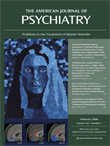Risk and Resilience Markers in Bipolar Disorder: Brain Responses to Emotional Challenge in Bipolar Patients and Their Healthy Siblings
Abstract
OBJECTIVE: The authors previously identified depression-specific differences in brain responses to an emotional challenge in patients with bipolar and unipolar mood disorder. In this study, potential markers of bipolar risk and resilience were examined in a new cohort of lithium-responsive bipolar patients and their healthy siblings. METHOD: Changes in regional cerebral blood flow (rCBF) were measured with [15O]water positron emission tomography after induction of transient sadness in nine euthymic lithium responders and nine healthy siblings. The patterns of change in these groups were compared, and then they were contrasted with previous findings on bipolar responders to valproate. RESULTS: Common to all three groups with induced sadness were rCBF increases in the dorsal/rostral anterior cingulate and anterior insula and decreases in the orbitofrontal and inferior temporal cortices. Distinguishing the groups were decreases in the medial frontal cortex in the patients but an increase in this region in the siblings. DISCUSSION: Common changes with emotional challenge were identified in bipolar patients and their healthy siblings. These were not seen previously in healthy subjects without a family history of mood disorder, suggesting a potential marker of bipolar risk. The siblings’ unique increases in the medial frontal cortex appear to identify a compensatory response in this at-risk group, as this pattern was not seen previously in healthy subjects without depression risk factors. This differential change pattern in patients and their siblings highlights the role of the anterior cingulate and medial frontal regions in mediating resiliency and vulnerability in bipolar disorder families.



